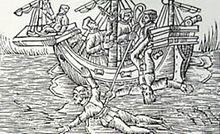Keelhauling (Dutch kielhalen;[1] "to drag along the keel") is a form of punishment and potential execution once meted out to sailors at sea. The sailor was tied to a line looped beneath the vessel, thrown overboard on one side of the ship, and dragged under the ship's keel, either from one side of the ship to the other, or the length of the ship (from bow to stern).

History
editThere is limited evidence that keelhauling in this form was used by pirate ships, especially in the ancient world. The earliest known mention of keelhauling is from the Greeks in the Rhodian Maritime Code (Lex Rhodia), of c. 700 BC, which outlines punishment for piracy. There is an image on a Greek vase, for example, from the same era that is either a representation of strappado — that is, hanging the victim over the water - or of a keelhauling proper. [2][3]
Several 17th-century English writers such as William Monson[4] and Nathaniel Boteler[5] recorded the use of keel-hauling on English naval ships. However, their references are vague and provide no date. There seems to be no record of it in English ships' logs of the era, and naval historian Nicholas Rodger has stated he knows of no firm evidence that it ever happened.[6][original research?] In 1880, George Shaw Lefevre was confronted in Parliament with a recent report from Italy of a keelhauling on HMS Alexandra, and denied that such an incident had taken place.[7]
Some historians believe keelhauling may have been introduced to the Dutch Navy by William of Orange.[8][9][10] On 11 October 1652, under Jan Van Riebeeck's command, Jan Blank, a sailor, was keelhauled, whipped a total of 150 lashes, and then enslaved for 2 years as punishment for deserting the VOC - he had deserted for just 9 days.[11][12] Perhaps the most graphic incident of it occurred in 1673 when Cornelis Evertsen the Youngest punished sailors who committed murder.[13] It was an official, though rare, punishment in the Dutch navy,[14] as shown in the painting The keel-hauling of the ship's surgeon of Admiral Jan van Nes. This shows a large crowd gathered to watch the event, as though it was a "show" punishment intended to frighten other potential offenders, as was flogging round the fleet.
A footnote in one source suggests that it may have evolved from the medieval punishment of ducking.[15]
The term still survives today, although usually in the sense of being severely rebuked.[16]
See also
editReferences
edit- ^ "Etymological origins". etymonline.com. Retrieved 9 August 2018.
- ^ H. A. Ormerod, Piracy in the Ancient World (New York: Dorset Press, 1987), 54–56.
- ^ C.E. Ioannidou, "The black version of water and underwater activity: drowning, Torture, and executions below The sea in ancient greece during The archaic and classical period"
- ^ Monson, William; Oppenheim, M. (Michael) (August 14, 1902). "The naval tracts of Sir William Monson". [London], Printed for the Navy Records Society – via Internet Archive.
- ^ Boteler’s Dialogues, ed. Perrin 11-25
- ^ Nicholas A. M. Rodger, 2017 Personal communication
- ^ "NAVY—ALLEGED INSTANCE OF "KEEL-HAULING'". HC Deb 04 September 1880 CE vol 256 c1275 api.parliament.uk/historic-hansard, accessed 8 August 2018.
- ^ Routledge, E. (1864). Routledge's Every Boy's Annual. Routledge, Warne & Routledge. p. 129. Retrieved 2022-10-10.
- ^ Biodiversity Heritage Library; White, W. (1907). Notes and Queries. Oxford University Press. p. 3-PA216. Retrieved 2022-10-10.
- ^ Wood, E. (1916). Our Fighting Services and how They Made the Empire. Cassell, Limited. p. 153. Retrieved 2022-10-10.
- ^ Van Riebeeck, Jan; et al. (Utrecht Historisch Genootschap) (1884). Dagverhaal van Jan Van Riebeeck, Deel 1 (1652-1655) (in Dutch). Utrecht: Kemink & Zoon. pp. 57–72.
- ^ Leibbrandt, H (1897). Riebeeck's Journal, Part 1 (December 1651 - December 1655). Cape Town: W A Richards & Sons, Government Printers. pp. 31–35.
- ^ Marley, D. (2010). Pirates of the Americas. ABC-CLIO. p. 194. ISBN 978-1-59884-201-2. Retrieved 2022-10-10.
- ^ The Dutch navy of the seventeenth and eighteenth centuries, Jaap R. Bruijn
- ^ "'Ducking' at the main yard arm is, when a malefactor by having a rope fastened under his arms and about his middle, and under his breech, is thus hois[t]ed up to the end of the yard; from whence he is again violently let fall into the sea, sometimes twice, sometimes three several times one after another; and if the offence be very foul, he is also drawn under the very keel of the ship...'". Dialogical Discourse of Marine Affairs, Nathaniel Boteler (1685)
- ^ "keelhaul". Merriam-Webster.com Dictionary. Merriam-Webster. Retrieved 2018-09-19.
- kielholen entry in: Johann Hinrich Röding: Allgemeines Wörterbuch der Marine in allen Europäischen Seesprachen nebst vollständigen Erklärungen. Nemnich, Hamburg & J.J. Gebauer, Halle, 1793–1798.